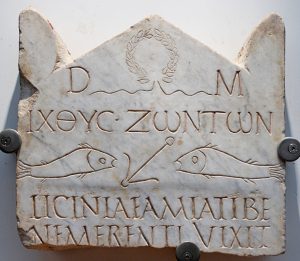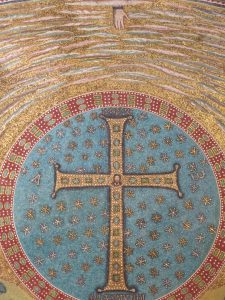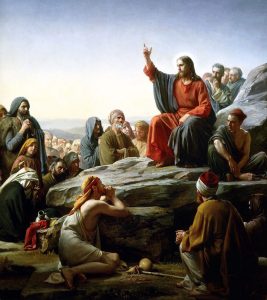Christianity originated in the 1st century in the Roman province of Judea after the crucifixion of Jesus, a man who declared himself to be the son of God.

Image source: https://en.wikipedia.org/wiki/Christ_Pantocrator#/media/File:Christ_Pantokrator,_Cathedral_of_Cefal%C3%B9,_Sicily.jpg
According to the Gospels, Jesus was a Jewish teacher and healer who proclaimed the imminent Kingdom of God and was crucified between c.30–33 AD. His followers believed that he was raised from the dead and exalted by God and that he would soon return to the beginning of God’s Kingdom.
Who was Jesus of Nazareth?

To better understand the birth of Christianity we must consider Jesus’ life and death since its history is focused on the life, death, and resurrection of one person, Jesus Christ, the son of God.
The traditional story of Jesus tells of his birth in a stable in Bethlehem, in the Holy Land, of a young virgin named Mary who became pregnant with the son of God by the work of the Holy Spirit. Little is known about Jesus after his birth until he began his ministry at the age of about 30. He later spent three years teaching, healing, and working miracles, with a group of twelve disciples in tow who helped him in his work. Jesus publicly claimed to speak, with the authority of God, following this claim the religious authorities in Palestine handed Jesus over to the Roman authorities as a revolutionary, so he was tried for heresy, condemned, and put to death by crucifixion. On the Sunday following his execution, some of his women followers discovered that his body was no longer in the tomb. Jesus then appeared to them, alive. His followers realized that God had raised Jesus from the dead, according to the Gospel accounts, he was taken up into heaven.
Context and Origin
By 30 B.C, Rome’s empire had expanded to cover virtually all of the lands adjacent to the Mediterranean Sea, including the land occupied by the Hebrews. The Romans had little tolerance for sedition or rebellion against their government so when the Jews resisted Roman control in 26 B.C. they established direct rule over the region appointing Pontius Pilate as governor of the territory. The Jews continued opposing the foreigner invader and refused to adore the Roman emperor as their god. In this climate of tension and oppression, many Jews believed in a messiah to free them from Roman rule. For some, this messiah was Jesus of Nazareth.

Image source: https://en.wikipedia.org/wiki/Pontius_Pilate#/media/File:Ecce_homo_by_Antonio_Ciseri_(1).jpg
Saint Paul, founder of the first church

Image source: https://commons.wikimedia.org/wiki/File:Saint_Paul,_Rembrandt_van_Rijn_(and_Workshop%3F),_c._1657.jpg
Most Jews rejected the idea of Jesus as their messiah. The Romans treated the early Christians as a small Jewish sect in the years following the death of Jesus. Everything changed with Paul of Tarsus. Paul began to spread Christianity more to non-Jews. Many destitute people in the region found solace in notions of a loving God and a life after death. The Romans persecuted these Christians. But Paul traveled extensively, and his successors did an excellent job of reaching converts. After nearly four centuries Christianity became the state religion of the Roman Empire in 395 C.E.
Apostolistic Age

Image source: https://search.creativecommons.org/photos/c8930224-e882-4eee-b855-911065e1bfcd by Prof. Mortel
The Apostolic Age takes its name from the Apostles and their missionary activities. A primary source for the Apostolic Age is the Acts of the Apostles, but its historical accuracy is questionable and its coverage is partial, focusing particularly from Acts 15:36 onwards on Paul’s ministry, and ending around 62 AD with Paul’s preaching in Rome under house arrest.
Persecutions
The early Christians were subjected to various persecutions. This even meant death. Early martyrs included Stephen (Acts 7:59) and James, son of Zebedee (Acts 12:2). Persecutions by the authorities of the Roman Empire began in the year 64 when Emperor Nero blamed them for the Great Fire of Rome as reported by the Roman historian Tacitus.
It was under Nero’s persecution that saints Peter and Paul became martyrs in Rome.

Image source: https://en.wikipedia.org/wiki/Caravaggio#/media/File:Crucifixion_of_Saint_Peter-Caravaggio_(c.1600).jpg
Ante-Nicene Period

Image source: https://en.wikipedia.org/wiki/Christianity_in_the_ante-Nicene_period#/media/File:Stele_Licinia_Amias_Terme_67646.jpg
The Ante-Nicene Period (literally “before Nicaea”) of the history of early Christianity was the period after the Apostolic Age until the First Council of Nicaea in 325. This period had a significant impact on the unity of doctrine throughout Christianity and the spreading of Christianity in a large area of the world. At the beginning of the Nicene period, the Christian faith had spread throughout Western Europe and the Mediterranean Basin, and to North Africa and the East. Several trends emerged simultaneously including an increasingly harsh rejection of Judaism, and an acceptance of religious antisemitism, however, many modern-day Christian theologians reject this charge.
Early Christian art
Early Christian art survives from dates close to the origins of Christianity. The oldest Christian sculptures came from sarcophagi, dating back to the beginning of the 2nd century. From the tombs of the Catacombs of Rome comes the largest groups of Early Christian paintings showing the evolution of the representation of Jesus, a process not complete until the 6th century, as the conventional aspect of Jesus in art remained remarkably consistent.

Until Constantine adopted Christianity, Christian art derived its style and its iconography from popular Roman folk art, but from that time on the great Christian buildings built under imperial patronage led to the need for Christian versions of the Roman elite and official art, of which the mosaics in churches in Rome are the most important surviving examples. Christian art was involved in the passage of style from the classical tradition inherited from Ancient Greek art to a less realistic and otherworldly hieratic style, the beginning of gothic art.
The early church
From the 1st to the early 4th centuries most Christian communities worshipped in private homes, often in secret. Some Roman churches, such as the Basilica of San Clemente in Rome, are built directly above the houses where early Christians worshipped. Other early Roman churches are built on the sites of Christian martyrdom or at the entrance to the catacombs where Christians were buried.

Image source: https://en.wikipedia.org/wiki/Church_architecture#
Christian architecture was adapted to civic and imperial forms, and so the Basilica, a large rectangular meeting room became a model for churches, with three naves and sometimes galleries and clerestory. The Christian basilica consisted of a single apse, plus they focused on the Eucharist as a symbol of the eternal, loving, and forgiving God.

Image source: https://search.creativecommons.org/photos/76de02d1-4f6e-4585-9a56-866447722971 by bradhostetler
The history of the Christian religion and the Christian church began with Jesus and his apostles. After becoming the state religion of the Roman Empire it spread into Northern Europe and Russia in the Middle Ages. During the Age of Exploration, Christianity expanded throughout the world and it is currently the largest religion in the world.
The Link with Jewish Faith
Most of the first Christians were ethnically Jewish or Jewish proselytes. An early difficulty came from non-Jewish converts. Many were the questions raised. For example, if they had to “become Jewish” before becoming Christian. St. Peter decided that they did not, and the matter was further addressed with the Council of Jerusalem.
Christianity kept many practices from Jewish tradition, Christians thought the Jewish scriptures to be sacred and used mostly the Septuagint edition and translation as the Old Testament and added other texts as the New Testament. Christians professed Jesus to be the God of Israel, having taken human form and considered Jesus to be the Messiah (Christ) who had been prophesied about in the Old Testament and so was expected by the people of Israel.

Image source: https://en.wikipedia.org/wiki/Jewish_Christian#/media/File:Bloch-SermonOnTheMount.jpg
Info sources:
https://www.bbc.co.uk/religion/ http://www.ushistory.org/civ/4h.asp https://en.wikipedia.org/wiki/History_of_Christianity#Apostolic_Age https://en.wikipedia.org/wiki/Christian_art https://en.wikisource.org/
